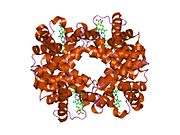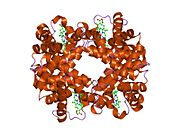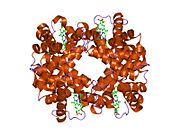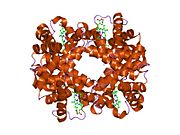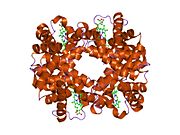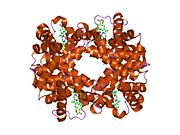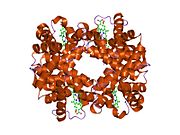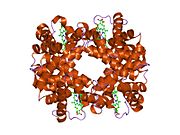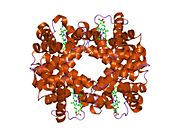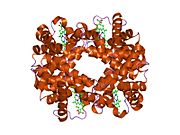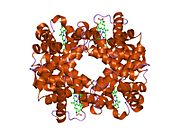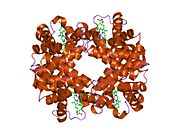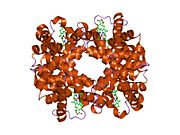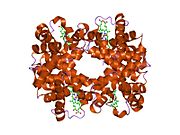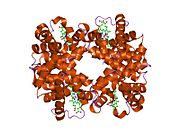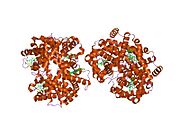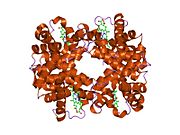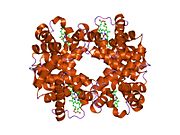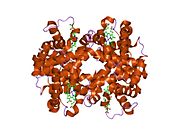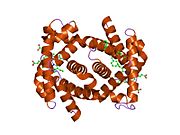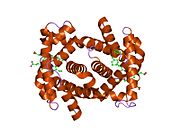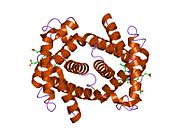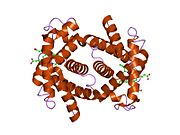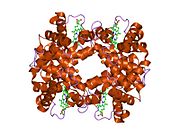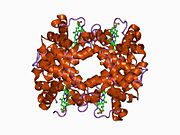-
1a00: HEMOGLOBIN (VAL BETA1 MET, TRP BETA37 TYR) MUTANT
-
1a01: HEMOGLOBIN (VAL BETA1 MET, TRP BETA37 ALA) MUTANT
-
1a0u: HEMOGLOBIN (VAL BETA1 MET) MUTANT
-
1a0z: HEMOGLOBIN (VAL BETA1 MET) MUTANT
-
1a3n: DEOXY HUMAN HEMOGLOBIN
-
1a3o: ARTIFICIAL MUTANT (ALPHA Y42H) OF DEOXY HEMOGLOBIN
-
1abw: DEOXY RHB1.1 (RECOMBINANT HEMOGLOBIN)
-
1aby: CYANOMET RHB1.1 (RECOMBINANT HEMOGLOBIN)
-
1aj9: R-STATE HUMAN CARBONMONOXYHEMOGLOBIN ALPHA-A53S
-
1b86: HUMAN DEOXYHAEMOGLOBIN-2,3-DIPHOSPHOGLYCERATE COMPLEX
-
1bab: HEMOGLOBIN THIONVILLE: AN ALPHA-CHAIN VARIANT WITH A SUBSTITUTION OF A GLUTAMATE FOR VALINE AT NA-1 AND HAVING AN ACETYLATED METHIONINE NH2 TERMINUS
-
1bbb: A THIRD QUATERNARY STRUCTURE OF HUMAN HEMOGLOBIN A AT 1.7-ANGSTROMS RESOLUTION
-
1bij: CROSSLINKED, DEOXY HUMAN HEMOGLOBIN A
-
1buw: CRYSTAL STRUCTURE OF S-NITROSO-NITROSYL HUMAN HEMOGLOBIN A
-
1bz0: HEMOGLOBIN A (HUMAN, DEOXY, HIGH SALT)
-
1bz1: HEMOGLOBIN (ALPHA + MET) VARIANT
-
1bzz: HEMOGLOBIN (ALPHA V1M) MUTANT
-
1c7b: DEOXY RHB1.0 (RECOMBINANT HEMOGLOBIN)
-
1c7c: DEOXY RHB1.1 (RECOMBINANT HEMOGLOBIN)
-
1c7d: DEOXY RHB1.2 (RECOMBINANT HEMOGLOBIN)
-
1cbl: THE 1.9 ANGSTROM STRUCTURE OF DEOXY-BETA4 HEMOGLOBIN: ANALYSIS OF THE PARTITIONING OF QUATERNARY-ASSOCIATED AND LIGAND-INDUCED CHANGES IN TERTIARY STRUCTURE
-
1cbm: THE 1.8 ANGSTROM STRUCTURE OF CARBONMONOXY-BETA4 HEMOGLOBIN: ANALYSIS OF A HOMOTETRAMER WITH THE R QUATERNARY STRUCTURE OF LIGANDED ALPHA2BETA2 HEMOGLOBIN
-
1cls: CROSS-LINKED HUMAN HEMOGLOBIN DEOXY
-
1cmy: THE MUTATION BETA99 ASP-TYR STABILIZES Y-A NEW, COMPOSITE QUATERNARY STATE OF HUMAN HEMOGLOBIN
-
1coh: STRUCTURE OF HAEMOGLOBIN IN THE DEOXY QUATERNARY STATE WITH LIGAND BOUND AT THE ALPHA HAEMS
-
1dke: NI BETA HEME HUMAN HEMOGLOBIN
-
1dxt: HIGH-RESOLUTION X-RAY STUDY OF DEOXY RECOMBINANT HUMAN HEMOGLOBINS SYNTHESIZED FROM BETA-GLOBINS HAVING MUTATED AMINO TERMINI
-
1dxu: HIGH-RESOLUTION X-RAY STUDY OF DEOXY RECOMBINANT HUMAN HEMOGLOBINS SYNTHESIZED FROM BETA-GLOBINS HAVING MUTATED AMINO TERMINI
-
1dxv: HIGH-RESOLUTION X-RAY STUDY OF DEOXY RECOMBINANT HUMAN HEMOGLOBINS SYNTHESIZED FROM BETA-GLOBINS HAVING MUTATED AMINO TERMINI
-
1fn3: CRYSTAL STRUCTURE OF NICKEL RECONSTITUTED HEMOGLOBIN-A CASE FOR PERMANENT, T-STATE HEMOGLOBIN
-
1g9v: HIGH RESOLUTION CRYSTAL STRUCTURE OF DEOXY HEMOGLOBIN COMPLEXED WITH A POTENT ALLOSTERIC EFFECTOR
-
1gbu: DEOXY (BETA-(C93A,C112G)) HUMAN HEMOGLOBIN
-
1gbv: (ALPHA-OXY, BETA-(C112G)DEOXY) T-STATE HUMAN HEMOGLOBIN
-
1gli: DEOXYHEMOGLOBIN T38W (ALPHA CHAINS), V1G (ALPHA AND BETA CHAINS)
-
1gzx: OXY T STATE HAEMOGLOBIN: OXYGEN BOUND AT ALL FOUR HAEMS
-
1hab: CROSSLINKED HAEMOGLOBIN
-
1hac: CROSSLINKED HAEMOGLOBIN
-
1hba: HIGH-RESOLUTION X-RAY STUDY OF DEOXYHEMOGLOBIN ROTHSCHILD 37BETA TRP-> ARG: A MUTATION THAT CREATES AN INTERSUBUNIT CHLORIDE-BINDING SITE
-
1hbb: HIGH-RESOLUTION X-RAY STUDY OF DEOXYHEMOGLOBIN ROTHSCHILD 37BETA TRP-> ARG: A MUTATION THAT CREATES AN INTERSUBUNIT CHLORIDE-BINDING SITE
-
1hbs: REFINED CRYSTAL STRUCTURE OF DEOXYHEMOGLOBIN S. I. RESTRAINED LEAST-SQUARES REFINEMENT AT 3.0-ANGSTROMS RESOLUTION
-
1hco: THE STRUCTURE OF HUMAN CARBONMONOXY HAEMOGLOBIN AT 2.7 ANGSTROMS RESOLUTION
-
1hdb: ANALYSIS OF THE CRYSTAL STRUCTURE, MOLECULAR MODELING AND INFRARED SPECTROSCOPY OF THE DISTAL BETA-HEME POCKET VALINE67(E11)-THREONINE MUTATION OF HEMOGLOBIN
-
1hga: HIGH RESOLUTION CRYSTAL STRUCTURES AND COMPARISONS OF T STATE DEOXYHAEMOGLOBIN AND TWO LIGANDED T-STATE HAEMOGLOBINS: T(ALPHA-OXY)HAEMOGLOBIN AND T(MET)HAEMOGLOBIN
-
1hgb: HIGH RESOLUTION CRYSTAL STRUCTURES AND COMPARISONS OF T STATE DEOXYHAEMOGLOBIN AND TWO LIGANDED T-STATE HAEMOGLOBINS: T(ALPHA-OXY)HAEMOGLOBIN AND T(MET)HAEMOGLOBIN
-
1hgc: HIGH RESOLUTION CRYSTAL STRUCTURES AND COMPARISONS OF T STATE DEOXYHAEMOGLOBIN AND TWO LIGANDED T-STATE HAEMOGLOBINS: T(ALPHA-OXY)HAEMOGLOBIN AND T(MET)HAEMOGLOBIN
-
1hho: STRUCTURE OF HUMAN OXYHAEMOGLOBIN AT 2.1 ANGSTROMS RESOLUTION
-
1ird: Crystal Structure of Human Carbonmonoxy-Haemoglobin at 1.25 A Resolution
-
1j3y: Direct observation of photolysis-induced tertiary structural changes in human hemoglobin; Crystal structure of alpha(Fe)-beta(Ni) hemoglobin (laser photolysed)
-
1j3z: Direct observation of photolysis-induced tertiary structural changes in human haemoglobin; Crystal structure of alpha(Fe-CO)-beta(Ni) hemoglobin (laser unphotolysed)
-
1j40: Direct observation of photolysis-induced tertiary structural changes in human haemoglobin; Crystal structure of alpha(Ni)-beta(Fe-CO) hemoglobin (laser unphotolysed)
-
1j41: Direct observation of photolysis-induced tertiary structural changes in human haemoglobin; Crystal structure of alpha(Ni)-beta(Fe) hemoglobin (laser photolysed)
-
1j7s: Crystal Structure of deoxy HbalphaYQ, a mutant of HbA
-
1j7w: Crystal structure of deoxy HbbetaYQ, a site directed mutant of HbA
-
1j7y: Crystal structure of partially ligated mutant of HbA
-
1jy7: THE STRUCTURE OF HUMAN METHEMOGLOBIN. THE VARIATION OF A THEME
-
1k0y: X-ray Crystallographic Analyses of Symmetrical Allosteric Effectors of Hemoglobin. Compounds Designed to Link Primary and Secondary Binding Sites
-
1k1k: Structure of Mutant Human Carbonmonoxyhemoglobin C (beta E6K) at 2.0 Angstrom Resolution in Phosphate Buffer.
-
1kd2: Crystal Structure of Human Deoxyhemoglobin in Absence of Any Anions
-
1lfl: DEOXY HEMOGLOBIN (90% RELATIVE HUMIDITY)
-
1lfq: OXY HEMOGLOBIN (93% RELATIVE HUMIDITY)
-
1lft: OXY HEMOGLOBIN (90% RELATIVE HUMIDITY)
-
1lfv: OXY HEMOGLOBIN (88% RELATIVE HUMIDITY)
-
1lfy: OXY HEMOGLOBIN (84% RELATIVE HUMIDITY)
-
1lfz: OXY HEMOGLOBIN (25% METHANOL)
-
1ljw: Crystal Structure of Human Carbonmonoxy Hemoglobin at 2.16 A: A Snapshot of the Allosteric Transition
-
1m9p: Crystalline Human Carbonmonoxy Hemoglobin C Exhibits The R2 Quaternary State at Neutral pH In The Presence of Polyethylene Glycol: The 2.1 Angstrom Resolution Crystal Structure
-
1mko: A Fourth Quaternary Structure of Human Hemoglobin A at 2.18 A Resolution
-
1nej: Crystalline Human Carbonmonoxy Hemoglobin S (Liganded Sickle Cell Hemoglobin) Exhibits The R2 Quaternary State At Neutral pH In The Presence Of Polyethylene Glycol: The 2.1 Angstrom Resolution Crystal Structure
-
1nih: Structure of deoxy-quaternary haemoglobin with liganded beta subunits
-
1nqp: Crystal structure of Human hemoglobin E at 1.73 A resolution
-
1o1i: Cyanomet hemoglobin (A-GLY-C:V1M,L29F,H58Q; B,D:V1M,L106W)
-
1o1j: Deoxy hemoglobin (A-GLY-C:V1M,L29F,H58Q; B,D:V1M,L106W)
-
1o1k: Deoxy hemoglobin (A,C:V1M; B,D:V1M,V67W)
-
1o1l: Deoxy hemoglobin (A-GLY-C:V1M,L29W,H58Q; B,D:V1M)
-
1o1m: Deoxy hemoglobin (A-GLYGLYGLY-C:V1M,L29F,H58Q B,D:V1M,V67W)
-
1o1n: Deoxy hemoglobin (A-GLYGLYGLY-C:V1M,L29W; B,D:V1M)
-
1o1o: Deoxy hemoglobin (A,C:V1M,V62L; B,D:V1M,V67L)
-
1o1p: Deoxy hemoglobin (A-GLY-C:V1M; B,D:V1M,C93A,N108K)
-
1qi8: DEOXYGENATED STRUCTURE OF A DISTAL POCKET HEMOGLOBIN MUTANT
-
1qsh: MAGNESIUM(II)-AND ZINC(II)-PROTOPORPHYRIN IX'S STABILIZE THE LOWEST OXYGEN AFFINITY STATE OF HUMAN HEMOGLOBIN EVEN MORE STRONGLY THAN DEOXYHEME
-
1qsi: MAGNESIUM(II)-AND ZINC(II)-PROTOPORPHYRIN IX'S STABILIZE THE LOWEST OXYGEN AFFINITY STATE OF HUMAN HEMOGLOBIN EVEN MORE STRONGLY THAN DEOXYHEME
-
1qxd: Structural Basis for the Potent Antisickling Effect of a Novel Class of 5-Membered Heterocyclic Aldehydic Compounds
-
1qxe: Structural Basis for the Potent Antisickling Effect of a Novel Class of 5-Membered Heterocyclic Aldehydic Compounds
-
1r1x: Crystal structure of oxy-human hemoglobin Bassett at 2.15 angstrom
-
1r1y: Crystal structure of deoxy-human hemoglobin Bassett at 1.8 angstrom
-
1rps: Crystallographic Analysis of the Interaction of Nitric Oxide with Quaternary-T Human Hemoglobin. Hemoglobin exposed to NO under anerobic conditions
-
1rq3: Crystallographic Analysis of the Interaction of Nitric Oxide with Quaternary-T Human Deoxyhemoglobin, Deoxyhemoglobin
-
1rq4: Crystallographic Analysis of the Interaction of Nitric Oxide with Quaternary-T Human Hemoglobin, HEMOGLOBIN EXPOSED TO NO UNDER AEROBIC CONDITIONS
-
1rqa: Crystallographic Analysis of the Interaction of Nitric Oxide with Quaternary-T Human Hemoglobin. Beta W73E hemoglobin exposed to NO under anaerobic conditions
-
1rvw: R STATE HUMAN HEMOGLOBIN [ALPHA V96W], CARBONMONOXY
-
1sdk: CROSS-LINKED, CARBONMONOXY HEMOGLOBIN A
-
1sdl: CROSS-LINKED, CARBONMONOXY HEMOGLOBIN A
-
1shr: Crystal structure of ferrocyanide bound human hemoglobin A2 at 1.88A resolution
-
1si4: Crystal structure of Human hemoglobin A2 (in R2 state) at 2.2 A resolution
-
1thb: REFINEMENT OF A PARTIALLY OXYGENATED T STATE HAEMOGLOBIN AT 1.5 ANGSTROMS RESOLUTION
-
1uiw: Crystal Structures of Unliganded and Half-Liganded Human Hemoglobin Derivatives Cross-Linked between Lys 82beta1 and Lys 82beta2
-
1vwt: T STATE HUMAN HEMOGLOBIN [ALPHA V96W], ALPHA AQUOMET, BETA DEOXY
-
1xxt: The T-to-T High Transitions in Human Hemoglobin: wild-type deoxy Hb A (low salt, one test set)
-
1xy0: T-to-THigh Transitions in Human Hemoglobin: alphaK40G deoxy low-salt
-
1xye: T-to-THigh Transitions in Human Hemoglobin: alpha Y42A deoxy low salt
-
1xz2: wild-type hemoglobin deoxy no-salt
-
1xz4: Intersubunit Interactions Associated with Tyr42alpha Stabilize the Quaternary-T Tetramer but are not Major Quaternary Constraints in Deoxyhemoglobin: alphaY42A deoxyhemoglobin no-salt
-
1xz5: T-to-THigh Quaternary Transitions in Human Hemoglobin: alphaL91A deoxy low-salt
-
1xz7: T-to-THigh Quaternary Transitions in Human Hemoglobin: alphaR92A deoxy low-salt
-
1xzu: T-to-THigh Quaternary Transitions in Human Hemoglobin: alphaD94G deoxy low-salt
-
1xzv: T-to-THigh Quaternary Transitions in Human Hemoglobin: alphaP95A deoxy low-salt
-
1y09: T-to-T(High) Quaternary Transitions in Human Hemoglobin: alphaN97A deoxy low-salt
-
1y0a: T-to-THigh Quaternary Transitions in Human Hemoglobin: alphaY140A deoxy low-salt
-
1y0c: T-to-THigh Quaternary Transitions in Human Hemoglobin: alphaY140F deoxy low-salt
-
1y0d: T-to-THigh Quaternary Transitions in Human Hemoglobin: desArg141alpha deoxy low-salt
-
1y0t: T-to-T(High) Quaternary Transitions in Human Hemoglobin: betaV1M deoxy low-salt (1 test set)
-
1y0w: T-to-THigh quaternary Transitions in Human Hemoglobin: betaV1M deoxy low-salt (10 test sets)
-
1y22: T-To-T(High) quaternary transitions in human hemoglobin: betaV33A deoxy low-salt (1 test set)
-
1y2z: T-To-T(High) quaternary transitions in human hemoglobin: betaV34G deoxy low-salt (1 test set)
-
1y31: T-To-T(High) quaternary transitions in human hemoglobin: betaY35A deoxy low-salt (1 test set)
-
1y35: T-To-T(High) quaternary transitions in human hemoglobin: betaY35F deoxy low-salt (1 test set)
-
1y45: T-To-T(high) quaternary transitions in human hemoglobin: betaP36A deoxy low-salt (10 test sets)
-
1y46: T-To-T(High) quaternary transitions in human hemoglobin: betaW37Y deoxy low-salt (10 test sets)
-
1y4b: T-To-T(High) quaternary transitions in human hemoglobin: betaW37H deoxy low-salt (10 test sets)
-
1y4f: T-To-T(High) quaternary transitions in human hemoglobin: betaW37A deoxy low-salt (10 test sets)
-
1y4g: T-To-T(High) quaternary transitions in human hemoglobin: betaW37G deoxy low-salt (10 test sets)
-
1y4p: T-To-T(high) quaternary transitions in human hemoglobin: betaW37E deoxy low-salt (10 test sets)
-
1y4q: T-To-T(High) quaternary transitions in human hemoglobin: betaF42A deoxy low-salt (1 test set)
-
1y4r: T-To-T(High) quaternary transitions in human hemoglobin: betaF45A deoxy low-salt (1 test set)
-
1y4v: T-To-T(High) quaternary transitions in human hemoglobin: betaC93A deoxy low-salt (1 test set)
-
1y5f: T-To-T(High) quaternary transitions in human hemoglobin: betaL96A deoxy low-salt (1 test set)
-
1y5j: T-To-T(High) quaternary transitions in human hemoglobin: betaH97A deoxy low-salt (1 test set)
-
1y5k: T-To-T(High) quaternary transitions in human hemoglobin: betaD99A deoxy low-salt (10 test sets)
-
1y7c: T-To-T(High) quaternary transitions in human hemoglobin: betaP100A deoxy low-salt (1 test set)
-
1y7d: T-To-T(High) quaternary transitions in human hemoglobin: betaP100G deoxy low-salt (1 test set)
-
1y7g: T-To-T(high) quaternary transitions in human hemoglobin: betaN102A deoxy low-salt (1 test set)
-
1y7z: T-To-T(High) quaternary transitions in human hemoglobin: betaN108A deoxy low-salt (1 test set)
-
1y83: T-To-T(High) quaternary transitions in human hemoglobin: betaY145G deoxy low-salt (1 test set)
-
1y85: T-To-T(High) quaternary transitions in human hemoglobin: desHIS146beta deoxy low-salt
-
1y8w: T-To-T(High) quaternary transitions in human hemoglobin: alphaR92A oxy (2mM IHP, 20% PEG) (10 test sets)
-
1ydz: T-To-T(High) quaternary transitions in human hemoglobin: alphaY140F oxy (2MM IHP, 20% PEG) (1 test set)
-
1ye0: T-To-T(High) quaternary transitions in human hemoglobin: betaV33A oxy (2MM IHP, 20% PEG) (1 test set)
-
1ye1: T-To-T(High) quaternary transitions in human hemoglobin: betaY35A oxy (2MM IHP, 20% PEG) (1 test set)
-
1ye2: T-To-T(High) quaternary transitions in human hemoglobin: betaY35F oxy (2MM IHP, 20% PEG) (1 test set)
-
1yen: T-To-T(High) quaternary transitions in human hemoglobin: betaP36A oxy (2MM IHP, 20% PEG) (10 test sets)
-
1yeo: T-To-T(High) quaternary transitions in human hemoglobin: betaW37A OXY (10 test sets)
-
1yeq: T-To-T(High) quaternary transitions in human hemoglobin: betaW37Y OXY (10 test sets)
-
1yeu: T-To-T(High) quaternary transitions in human hemoglobin: betaW37G OXY (10 test sets)
-
1yev: T-To-T(High) quaternary transitions in human hemoglobin: betaW37E OXY (10 test sets)
-
1yff: STRUCTURE OF HUMAN CARBONMONOXYHEMOGLOBIN C (BETA E6K): TWO QUATERNARY STATES (R2 and R3) IN ONE CRYSTAL
-
1yg5: T-To-T(High) quaternary transitions in human hemoglobin: betaW37H OXY (2MM IHP, 20% PEG) (10 test sets)
-
1ygd: T-To-T(High) quaternary transitions in human hemoglobin: betaW37E alpha zinc beta oxy (10 TEST SETS)
-
1ygf: T-to-T(high) quaternary transitions in human hemoglobin: betaH97A oxy (2MM IHP, 20% PEG) (1 test set)
-
1yh9: T-to-T(High) quaternary transitions in human hemoglobin: HbA OXY (2MM IHP, 20% PEG) (10 test sets)
-
1yhe: T-To-T(High) quaternary transitions in human hemoglobin: HbA OXY (5.0MM IHP, 20% PEG) (10 test sets)
-
1yhr: T-To-T(High) quaternary transitions in human hemoglobin: HbA OXY (10.0MM IHP, 20% PEG) (10 test sets)
-
1yie: T-to-thigh quaternary transitions in human hemoglobin: betaW37A oxy (2.2MM IHP, 13% PEG) (1 test set)
-
1yih: T-to-T(High) quaternary transitions in human hemoglobin: betaP100A oxy (2.2MM IHP, 20% PEG) (1 test set)
-
1yvq: The low salt (PEG) crystal structure of CO Hemoglobin E (betaE26K) approaching physiological pH (pH 7.5)
-
1yvt: The high salt (phosphate) crystal structure of CO Hemoglobin E (Glu26Lys) at physiological pH (pH 7.35)
-
1yzi: A novel quaternary structure of human carbonmonoxy hemoglobin
-
2d5z: Crystal structure of T-state human hemoglobin complexed with three L35 molecules
-
2d60: Crystal structure of deoxy human hemoglobin complexed with two L35 molecules
-
2dn1: 1.25A resolution crystal structure of human hemoglobin in the oxy form
-
2dn2: 1.25A resolution crystal structure of human hemoglobin in the deoxy form
-
2dn3: 1.25A resolution crystal structure of human hemoglobin in the carbonmonoxy form
-
2h35: Solution structure of Human normal adult hemoglobin
-
2hbc: HIGH RESOLUTION X-RAY STRUCTURES OF MYOGLOBIN-AND HEMOGLOBIN-ALKYL ISOCYANIDE COMPLEXES
-
2hbd: HIGH RESOLUTION X-RAY STRUCTURES OF MYOGLOBIN-AND HEMOGLOBIN-ALKYL ISOCYANIDE COMPLEXES
-
2hbe: HIGH RESOLUTION X-RAY STRUCTURES OF MYOGLOBIN-AND HEMOGLOBIN-ALKYL ISOCYANIDE COMPLEXES
-
2hbf: HIGH RESOLUTION X-RAY STRUCTURES OF MYOGLOBIN-AND HEMOGLOBIN-ALKYL ISOCYANIDE COMPLEXES
-
2hbs: THE HIGH RESOLUTION CRYSTAL STRUCTURE OF DEOXYHEMOGLOBIN S
-
2hco: THE STRUCTURE OF HUMAN CARBONMONOXY HAEMOGLOBIN AT 2.7 ANGSTROMS RESOLUTION
-
2hhb: THE CRYSTAL STRUCTURE OF HUMAN DEOXYHAEMOGLOBIN AT 1.74 ANGSTROMS RESOLUTION
-
2hhd: OXYGEN AFFINITY MODULATION BY THE N-TERMINI OF THE BETA-CHAINS IN HUMAN AND BOVINE HEMOGLOBIN
-
2hhe: OXYGEN AFFINITY MODULATION BY THE N-TERMINI OF THE BETA CHAINS IN HUMAN AND BOVINE HEMOGLOBIN
-
3hhb: THE CRYSTAL STRUCTURE OF HUMAN DEOXYHAEMOGLOBIN AT 1.74 ANGSTROMS RESOLUTION
-
4hhb: THE CRYSTAL STRUCTURE OF HUMAN DEOXYHAEMOGLOBIN AT 1.74 ANGSTROMS RESOLUTION
-
6hbw: Crystal structure of deoxy-human hemoglobin beta6 glu->trp

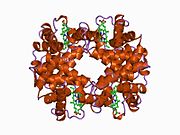
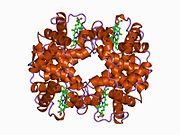

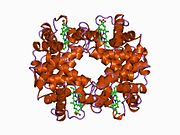






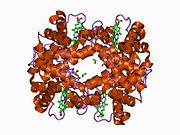


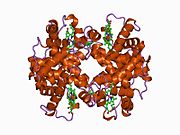



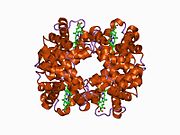



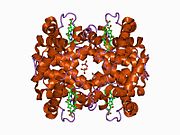

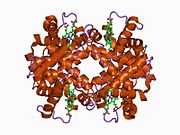




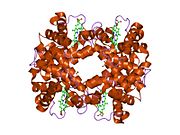









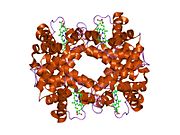














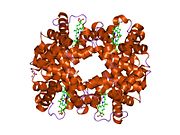
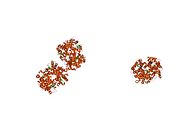

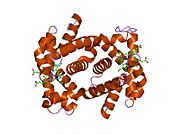











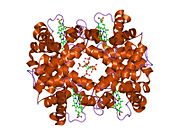













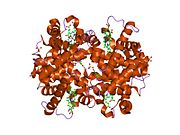

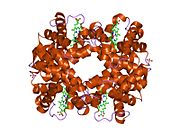

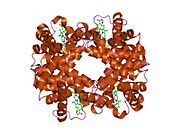


![1rvw: R STATE HUMAN HEMOGLOBIN [ALPHA V96W], CARBONMONOXY](http://upload.wikimedia.org/wikipedia/commons/thumb/f/f5/PDB_1rvw_EBI.jpg/180px-PDB_1rvw_EBI.jpg)
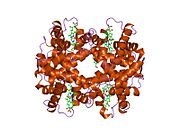


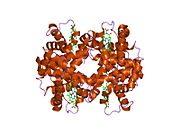


![1vwt: T STATE HUMAN HEMOGLOBIN [ALPHA V96W], ALPHA AQUOMET, BETA DEOXY](http://upload.wikimedia.org/wikipedia/commons/thumb/7/75/PDB_1vwt_EBI.jpg/180px-PDB_1vwt_EBI.jpg)






